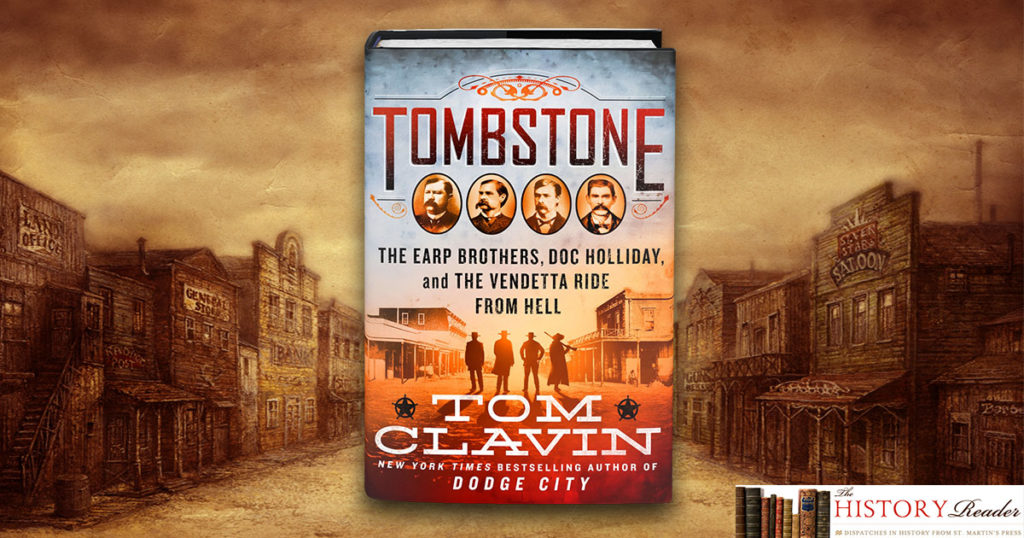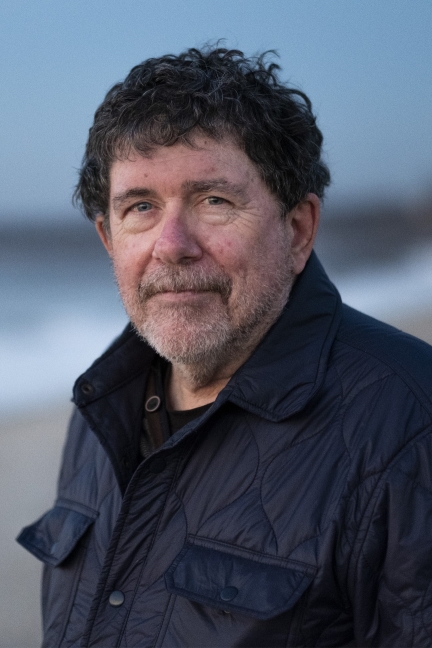by Tom Clavin
Tom Clavin tells the story of the establishment of Tombstone, the mining town that Wyatt Earp would one day cement in the annals of frontier history.
It can be said that the founding of Tombstone originated in Germany in 1702 when Johann Jacob Schieffelin was born. He visited America in 1743, found Philadelphia to his liking, and six years later returned to it with his wife and children. Johann had a son named Jacob who had a son named Jacob who had a son named Jacob who had a son named…Clinton. He was born in 1823 in New York City and was the first Schieffelin to head west.

This image is in the public domain via Wikicommons.
That adventure began in 1852 when Clinton and the brother of his wife, Jane Walker, who had emigrated from Ireland, set off for California to see if there was any gold left in them thar hills. There was not, so Clinton and Joe Walker went north to Oregon and purchased a claim on the Rogue River. That is where Jane was reunited with her husband when she finally made the perilous continental crossing in 1857, perhaps wondering, as she shuddered along the rutted roads, if even a potato famine back in Ireland was a better fate. The couple would have nine children, with the oldest to achieve adulthood being Edward Lawrence Schieffelin. He had been born on October 8, 1847, in Pennsylvania, which meant that he made the long journey west with his mother.
Ed’s first taste of mining life came when he was nineteen and visited camps along the Rogue River. He found the mechanics of the primitive hydraulic systems used to search for gold in the river fascinating. But Schieffelin was a restless man, and by the early 1870s he was in southeast Nevada, where silver was being found. He explored more of that territory as well as parts of Utah and Arizona. On most if not all of these sojourns, he traveled solo, and it is remarkable that he survived the dangers he faced, including hostile Indians, hostile whites, and hostile weather events.
“If you want to get really badly scared, just get caught in a box canyon once during one of those thunderstorms or cloud bursts, as they are usually called in Nevada and Arizona,” Schieffelin wrote in a memoir published years later. “Once will do you, and you always afterward will take good care to be out of them whenever there is one of those storms coming up.”
He went on to describe his own experience of “every jump digging the spurs in to the flanks of your horse trying to make him increase his jumps. And looking back over your shoulder, see that roll of water, mud, logs, sticks and rocks making a wall six or eight feet high, tumbling and rolling, sweeping all before it, and knowing that at least half a mile had to be made over the rocks, cactus, brush and such things before you would have a chance to escape.”
Despite the risks, it was during this time that his hunger for a big strike formed and over the years became ravenous. One of Schieffelin’s prospecting trips took him to the Grand Canyon. However, with that site offering little in riches other than visual ones, in 1877 he was employed as a scout operating out of Camp Huachuca. This was actually a pretty ideal situation, because as he roamed the area on the lookout for renegade Apaches he could also be searching for signs that indicated an ore deposit. One has to wonder how dedicated Schieffelin was to his official duties with the distraction of the next big strike constantly on his mind. It is also beyond fortunate that he did not get picked off by renegade Indians during his far-and-wide wanderings, which he continued to do alone so as not to tip anyone else off if there was ore to be found. “Not once did I build a fire,” Schieffelin boasted.
He made sure his mule was with him wherever he paused to do some prospecting. “She was always on the alert, better than a dog, and seemed to have a realization of the danger she was in, always saddled with the bridle hanging to the horn. Rifle in one hand and pick in the other, cartridge belt and six-shooter around me day or night just the same. After doing so for a while, I would pack up and go off to some other part of the country for a week or so, return and try it again and so on all summer.”
Eventually, Schieffelin found his way to the Dragoon Mountains. He later contended that he had a hunch about this range. One day he found “float ore,” pieces of ore found in water. They could mean nothing, or they could have been washed away from a substantial deposit. Ever a patient man, on his daily treks Schieffelin traced the source, which he hoped would be a mother lode of silver. Back at the camp, a few soldiers saw the “stones” of float ore, and Schieffelin admitted that he was prospecting during his outings to scout for Indians. They told him, “The only stone you’ll find out there will be your tombstone.” Thus, we can thank a handful of anonymous troopers for one of the most famous town names in American history.
He brought his float ore to Tucson but found no takers. “I had been carrying it around town to see if I couldn’t get somebody interested,” Schieffelin reported. “But it was no go. With very few exceptions they wouldn’t take a look at it and those that did pronounced it very low grade. And a man that at that time would have put up $150 or $200 would have owned half of Tombstone, for with that much money then I could have found any mine there was in Tombstone, because there was no prospectors in the country and before anybody had found them out, I would have them all.”
An unhappy irony for Schieffelin was that he might have a financial tiger by the tail but could be too broke to do anything about it. The prospector, by then soon to turn thirty, roamed through Tucson with all of thirty cents in his ragged pocket. “I found that Tucson was no place for a prospector,” he lamented. His first claim, which he had named Tombstone, might well be his last.
His solitary wanderings in the Dragoons had not improved his appearance from previous years. The early Arizona historian James McClintock, whose brother Charles published The Phoenix Herald, described the visitor as “about the queerest specimen of humanity ever seen in Tucson.”
This was saying something on the southwest frontier. McClintock further detailed that Schieffelin’s clothing “was worn and covered with patches of deerskins, corduroy and flannel, and his old slouch hat too, was so pieced with rabbit skin that very little of the original felt remained.” McClintock estimated his age as forty. “His black hair hung down below his shoulders, and his full beard, a tangle of knots, was almost as long and he appeared to be a fur-bearing animal.”
Accompanying the odd-looking prospector was a man named William Griffith, whom Schieffelin had at least partly confided in and who offered to pay recording fees in return for a piece of any claim. This became moot when no one in Tucson was impressed by the samples the two men had brought, and there was no assay office there anyway to examine and verify that silver ore was present. That was enough for Griffith—he quit as a partner and went off to find a job on a ranch.
Schieffelin turned north, to Globe. There he expected to find his brother Al, who he hoped would underwrite a proper prospecting expedition. But Al had moved on to Signal City to labor in the McCracken Mine. By now flat broke, Ed essentially took his brother’s former job in the Silver King Mine. Ed’s job was to spend every night cranking a hand windlass to hoist tons of silver ore. When he had earned what he hoped was enough, Ed pushed on to Silver City.

Attribution: Rob Lavinsky, iRocks.com – CC-BY-SA-3.0
He got lucky. Not only was Al still there but so was Richard Gird, the McCracken Mine’s assayer. His later claim to fame was as the founder of Chino, California, but at the time Gird was a respected assayer and, more important to Tombstone, he did not dismiss Ed Schieffelin based on his disheveled appearance but agreed to examine the samples he had brought. His jaw-dropping conclusion was that the ore not only was the real deal but could be worth $2,000 a ton. The peculiar prospector was right after all.
The Schieffelin brothers and Gird hurriedly formed a partnership and then gathered supplies and a mule for the trip south. To reduce the risk of being followed, the trio waited until dark to slip out of town. The brothers were not missed during the next few days, but some prospectors wondered what was so important to persuade Gird to leave his position at the McCracken Mine.
It was not until late February 1878 that the trio entered the San Pedro Valley. Ed was disturbed, to say the least, to find other prospectors working near the two sites containing silver ore that, tongue-in-cheek, he had named Tombstone and Graveyard. Further digging and examining confirmed that there was indeed a mother lode of silver in this section of the Dragoons, with new estimates by a giddy Gird being as high as $15,000 per ton. This was indeed the “Eureka” strike that Ed Schieffelin had always sought.
As the partners were digging and assaying and recording adjacent claims, word of the discovery spread like a prairie fire. Other prospectors arrived in the area, trailed by those who would make money off them. The first town to be created was Goose Flats, on a mesa overlooking another one of the Schieffelins’ claims, called Tough Nut because it had been more difficult to find.
Soon the hills were crawling with competing prospectors, and investors were drawn to the area to underwrite new ventures. According to Jeff Guinn, “Almost everyone camped in tents; they had no time or inclination to build anything more substantial. Comfort was secondary to the near-hysterical urge to strike it rich fast, before the fellow camping nearby beat you to it.”
The first miners’ meeting was held in 1878, and the Tombstone Mining District was created. This confirmed that the area was bursting with silver, with one estimate as high as $85 million worth. What had happened in California, in Nevada, and in Colorado was now happening in the southeast corner of Arizona—the boom was on.
The original Goose Flats site grew until March 1879, when a man named Solon Allis laid out the grid for what was to be a new and bigger town. This would be named after Ed Schieffelin’s first discovery, Tombstone.
The indefatigable prospector did indeed become rich, and his persistence and discovery spawned what would become one of the most famous towns in the United States. However, except for in Tombstone itself, the name of Schieffelin would be lost in the mists of history. The name that truly put Tombstone on the map was Earp.


Tom Clavin is a #1 New York Times bestselling author and has worked as a newspaper and web site editor, magazine writer, TV and radio commentator, and a reporter for The New York Times. He has received awards from the Society of Professional Journalists, Marine Corps Heritage Foundation, and National Newspaper Association. His books include The Heart of Everything That Is, Halsey’s Typhoon, and Reckless. He lives in Sag Harbor, NY.
